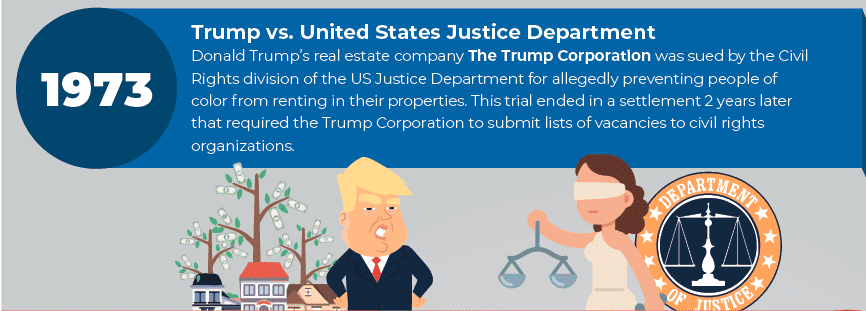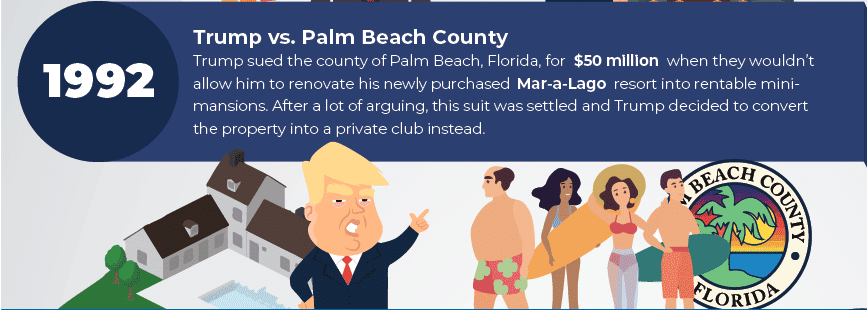News
Deep Dive: Donald Trump’s Long History of Lawsuits
Published
5 years agoon
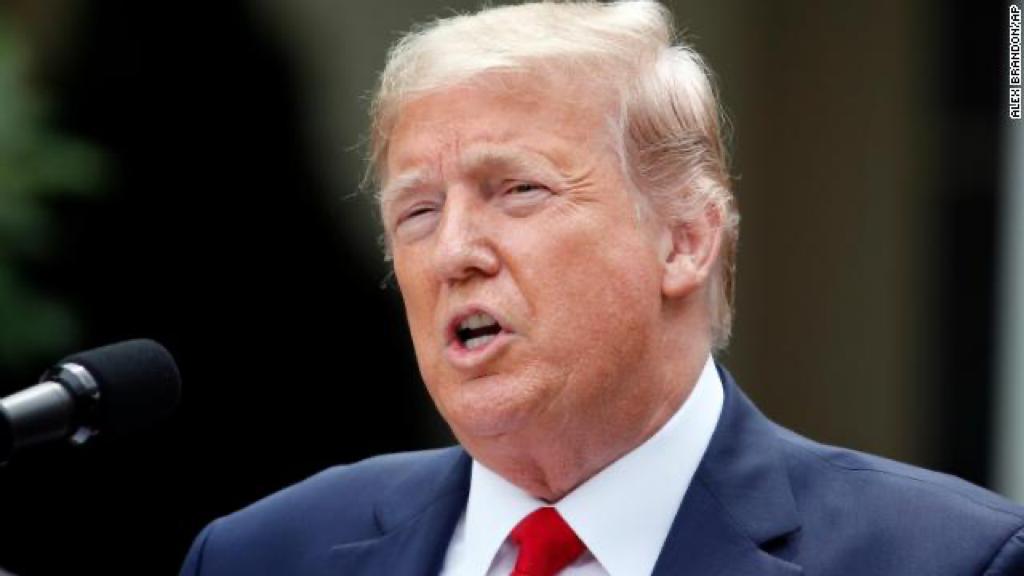
The Greatest Hits | Real Estate | Business | Entertainment | Politics | Key Takeaways
There’s a common saying about lawsuits: the only real winners are the lawyers. That’s because almost all legal battles are lengthy and painful for the wallets, reputations, and mental well-beings of everyone involved.
In this context, lawsuits are considered by many people to be dramatic and emotional affairs, as demonstrated by popular films on the subject such as Philadelphia and Erin Brockovich. However, the reality is that litigation is rarely as interesting as portrayed in the movies; the vast majority of lawsuits are boring, miserable, and inconsequential for all but a handful of people.
Despite the overwhelming negativity that comes from lawsuits, they’ve only become a more and more popular practice in America. This can be seen in the consistent growth of working lawyersin the country since the late 1800’s, the growing salaries of legal professionals, and in the increased spending on litigation by large companies in recent years. Aside from business lawsuits and federal lawsuits, legal action among individuals in civil court has also been on the rise over the past 30 years: from around 460,000 cases in 1990 to over 650,000 in 2018, according to data from United States Courts.
Whether it’s big business, entertainment, politics, or individual grievances, litigation has long been considered one of America’s favorite pastimes. What better way to demonstrate this long-standing trend than by looking at the extensive legal history of the most powerful man in the country?
Aside from business lawsuits and federal lawsuits, legal action among individuals in civil court has also been on the rise over the past 30 years: from around 460,000 cases in 1990 to over 650,000 in 2018
TRUMP’S LAWSUITS: THE GREATEST HITS
Donald J. Trump, the 45th President of the United States, has been involved in over 4,000 legal battles in some capacity. From his beginnings in the real estate and gambling industries during the 70’s and 80’s, to his entrepreneurial and entertainment ventures in the 90’s and early 2000’s, all the way to his baffling transition into politics in the 2010’s, Trump has been fighting courthouse battles every step of the way.
Before going any further, here’s a quick disclaimer: this piece is meant to be educational and is not a politically motivated attack on the President. Whether or not Trump has committed any wrongdoings — or is culpable for any wrongdoings — is not the point of this piece. Instead, the goal here is to use his history to understand the reality of lawsuits and how they typically occur in different American industries.
Also, this article won’t discuss all 4,000+ lawsuits in which he’s been involved— that’s just not possible! Instead, let’s take a look at some of Trump’s highest profile cases with the greatest educational value.
Keep reading to take a look at our breakdown of Donald Trump’s most significant and infamous cases!

TRUMPS’ REAL ESTATE LAWSUITS
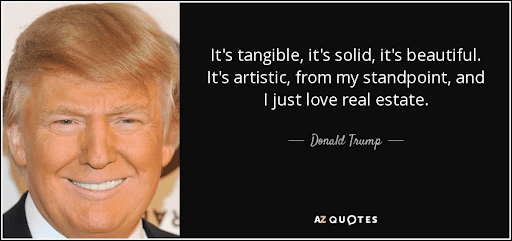
Before becoming an entertainment mogul and politician, Donald Trump began his career in 1968 at his father’s New York-based real estate company. He became the company’s president 3 years later, naming it The Trump Organization. In his time as president of his business, he supervised many real estate bids, purchases, and projects— many of which involved lengthy legal battles at the federal, state, and civil level.
Here are some of the noteworthy cases Trump fought as a real estate mogul:
1973 – 1975: United States v. Fred C. Trump, Donald J. Trump & Trump Management, Inc.
During the 70’s, the primary business projects of the Trump Organization involved constructing and renovating hotels, skyscrapers, and apartments in New York City. Actions that were allegedly performed at some of these properties resulted in a civil rights case against Trump, his father, and their business, with the United States Justice Department Civil Rights Division as the prosecution.
This particular lawsuit was filed in federal court instead of state or civil court. This is due to the fact that it involved accusations of violating civil rights law, making it a federal issue. In particular, the plaintiff claimed the Trump Organization violated The Fair Housing Act of 1968, which prohibits “landlords and real estate companies” from “[making] housing unavailable to persons” based on factors such as their race, religion, disabilities, and similar criteria.

According to an article in the New York Timesfrom the year in which the suit was filed, the U.S Justice Department claimed that the Trump Organization violated The Fair Housing Act because they “required different rental terms and conditions because of race,” in addition to “[misrepresenting] to blacks that apartments were not available.” According to official court documents, Trump denied any discriminationand his lawyer Roy Cohn moved to dismiss the case due to a lack of substantial evidence. Furthermore, he also filed a counterclaim based on damage to Trump’s reputation due to the above New York Times article, requesting $100 million from the U.S. government in damages.
Winner: Draw
This case was settled two years later. As part of the settlement, the Trump Organization was required to submit lists of apartment vacancies to local civil rights organization the New York Urban League. According to another New York Times article, the goal of this action was to enable the league to “provide qualified applicants for every fifth vacancy in those Trump buildings where blacks… occupy fewer than 10 percent of the apartments.” Since this settlement didn’t imply any guilt on the part of Trump or his business but did require his company to take action to encourage more diverse tenants, it can essentially be considered a draw.
1982 – 1986: Tenants of 100 Central Park South v. Donald J. Trump & Park South Associates
One of the many New York real estate business ventures that built Trump’s reputation involved a 14-story apartment complex at 100 Central Park South. Now renamed Trump Parc East, this used to be a rent-controlled property, which meant there were many tenants living there who paid far below the average rental costs for that area. Naturally, this isn’t an ideal situation for a landlord to be in— especially if they’re interested in renovating the entire property to increase its value, as Trump was.

Image Source: Zillow
CNNMoney outlines the lengthy legal battle that ensued over this conflict of interest based on researching the 2,895 different court documents involved in the case. Starting with his purchase of the property in 1981, tenants allege that Trump did everything in his power to force rent-controlled tenants to move. A 1985 New York Times article outlines some of the different tactics the 60-odd tenants claimed Trump engaged in, which included:
- Threatening to demolish the property
- Suing individual tenants in civil court
- Limiting important services like water and heat
- Neglecting to fix issues with plumbing and water damage
- Hiring spies to gather tenants’ personal information
- “Engaging in a psychological tug-of-war to wear the tenants down”
One of Trump’s alleged schemes to vacate tenants is outlined in another New York Times article from 1983. Dripping with sarcasm, this piece describes how Trump planned on temporarily filling vacant apartments with New York’s homeless— seemingly in the hopes of scaring away the other tenants. However, the Human Resources Administration rejected his Machiavellian offer, saying that it “left [them] with an uncomfortable feeling.” This bizarre episode was also included in the tenants’ legal complaints.
Winner: Tenants
Although Trump would claim victory in his autobiography and in future conversations about the affair, it appears plain as day that the tenants were the real winners. As a 1986 New York Timesarticle describes it, a settlement was reached between both parties that ended all litigation. The tenants were allowed to continue living in the building with their controlled rent, and Trump would instead be renovating the existing structure instead of demolishing it. Trump also ended up paying out $550,000 to the tenants’ attorneys. Obviously, this sum isn’t a big deal to a billionaire; however, it’s a concession that can definitely be seen as an admission of defeat.
1992 – 1997: Donald J. Trump & Mar-a-Lago Club, Inc. v. Palm Beach County
Although Trump’s tumultuous real estate career is largely defined by his New York-based projects, his 1985 acquisition of the historical Mar-a-Lago resort in Palm Beach, Florida is equally significant to his East Coast efforts with regards to his legacy. Since obtaining this property, many lawsuits were filed by Trump against the city in the 1990’s, showcasing his trademark business strategy of weaponized litigation.
The lawfare began in 1992, when Trump decided he was going to convert the property into private mansions in order to rent them out and repay his exorbitant debts. This move was blocked by Palm Beach County, since they viewed the property as a longstanding historical landmark. As outlined in an article from The Palm Beach Post that year, Trump’s response was to file a $50 million lawsuit accusing the county of “conflicts of interest, private meetings, special-interest lobbying and biased board members.”
Another suit was filed in 1995 by Trump accusing the county of harassing Mar-a-Lago visitors by directing air traffic over the property at low altitudes. An article from the Sun Sentinelchronicles this specific legal battle, which included an accusation from Trump that a judgemental county airport director was “seeking revenge by attacking Mar-a-Lago from the air.”
Trump’s reason for believing that Palm Beach County was constantly persecuting him and his club was brought up in yet another lawsuit filed in 1997. An archived article from the Wall Street Journal that same year describes how he filed a discrimination suit for $100 million which claims the Mar-a-Lago was persecuted “because it is open to Jews and African Americans.”
Winner: Trump
After consulting with lawyer Paul Rampell, Trump settled his 1992 lawsuit by converting the Mar-a-Lago into “a private club that is open to everyone.” Although this sounds like an oxymoron, what it meant in practice was that Trump could freely attract wealthy individuals to join his club that didn’t fit in with the rest of the Palm Beach crowd. His 1995 air traffic lawsuit was settled after convincing the county to lease him 215 acres of barren land in exchange, which became a lucrative private golf club. Finally, the 1997 discrimination lawsuit resulted in most of the county’s restrictions being lifted, allowing him to run his private club as he saw fit.
Ultimately, all of these lawsuits directed at Palm Beach County in the 90’s resulted in victories for Trump, even if the suits themselves ended in settlement deals. As a 2016 Vanity Fair articlerecounted, these lawsuits served a cunning purpose— to completely transform Palm Beach society in order to better suit his personal and professional ambitions. In fact, Trump went on to implement a similar strategy in 2002 when purchasing and renovating a golf course in Rancho Palos Verdes, California.
Ultimately, all of these lawsuits directed at Palm Beach County in the 90’s resulted in victories for Trump, even if the suits themselves ended in settlement deals.
TRUMP’S BUSINESS LAWSUITS

Donald Trump was able to build enough momentum from his real estate career to branch out into many different business ventures. This transition began with his acquisition of several casinos in Atlantic City, New Jersey, over the 1980’s and 1990’s. From there, he also explored entrepreneurial opportunities in food, education, and entertainment (more on that later).
Here are just a few of the most interesting gambling, entrepreneurship, and other business-related lawsuits fought by Trump:
1990 – 1991: Marvin B. Roffman v. Donald J. Trump & Trump Organization, Inc.
In addition to his numerous real estate projects in New York and Florida, Trump dabbled in several gaming-related projects in New Jersey by purchasing and renovating several casinos located on the Atlantic City boardwalk. First it was the Trump Plaza Hotel and Casino in 1986, followed by the Trump Marina, Trump Taj Mahal, and Trump World’s Fair in the late 80’s and early 90’s.
Although all of Trump’s forays into casino ownership were disastrous and led to bankruptcy, the Trump Taj Mahal was notorious for the numerous legal battles centered around it. Even before purchasing the property, Trump had to fight talk show host Merv Griffin with multiple lawsuits just to obtain ownership, as described in a Los Angeles Times article from 1988.
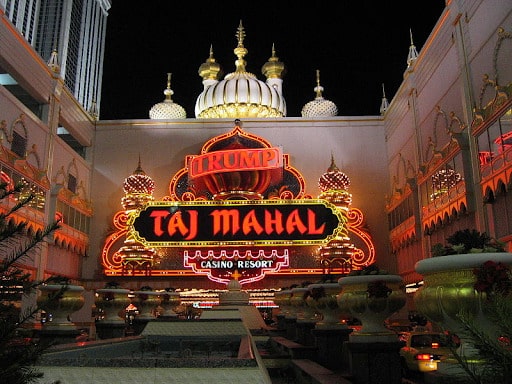
Photo taken by Jesper Rautelle Balle (CC BY 3.0)
However, the most notorious lawsuit relating to this doomed property involved financial analyst Marvin B. Roffman. According to a New York Times article from that time, he was fired from his position due to harsh criticism and multiple lawsuit threats from Trump. The reason for the real estate mogul’s ire was that Roffman had gone on record saying that the Trump Taj Mahal was bound to fail due to high operating costs and an imminent downturn in the market. After being constantly bad-mouthed by Trump in the press, Marvin Roffman decided to file a $2 million suit against Trump and his company for defamation in order to defend his professional reputation.
Winner: Draw
Ultimately, the defamation lawsuit ended in a settlement. Since this means that no official verdict was reached, Trump wasn’t proven to have engaged in libel or slander. However, the settlement also meant that he had to work out a satisfactory agreement with Roffman in exchange for clearing up his reputation. The specific details of this settlement are confidential; however, according to a statement given to the AP, Roffman was “extremely happy” with the results.
As a New York Times article from 1991 describes, the financial advisor also received a payout of $750,000 from his former employer as ordered by an arbitration panel from the New York Stock Exchange. However, what’s most significant in this case is what happened over the next few years. Roffman’s initial comments that got him in so much trouble were proven to be accurate after the Trump Taj Mahal struggled to stay open and eventually went under. This ultimately solidified his reputation as a competent financial analyst, resulting in a draw for both parties.
2008 – 2009: Donald J. Trump v. Deutsche Bank
Trump’s bombastic and highly ambitious business strategies have undeniably led to some impressive victories, but it’s also led to many disastrous losses. In fact, it can be argued that Trump’s true strength in business isn’t finding great deals, but maneuvering his way out of the bad ones in order to avoid the consequences of failure. The best way to illustrate this point is through his lawsuit against a German bank in the late 2000’s.
2008 saw the beginning of the Great Recession, a term now used to describe the worst global financial crisis since the Great Depression. One of the most significant factors that led to this recession was the bursting of the subprime mortgage bubble, which involved granting substantial high-risk loans to property owners with poor credit. Unsurprisingly, many of these lenders were unable to pay back their loans— which is precisely the situation Trump found himself in when he had to repay a $334 millionloan to Deutsche Bank for a Chicago skyscraper his company was in the process of building.
When facing potential consequences for failing to pay back this loan, Trump decided to sue the bank for $3 billion in damages to his reputation and the project. A 2008 New York Times articleoutlined his justification for the lawsuit, which was mainly to attest that he shouldn’t be forced to repay the loan in the initially agreed-upon time period.
Winner: Trump
The crux of Trump’s argument outlined in his lawsuit was the presence of a force majeure clause, which is also commonly referred to as an “Act of God.” Force majeure is a common addition to many legal agreements that removes liability from either party to fulfill it if they are affected by events that are out of their control. And according to Trump, the 2008 financial crisis counted as such an act, rendering him no longer beholden to the original deal.
As this archived article from the Wall Street Journal describes it, this initial lawsuit caused Deutsche Bank to file their own countersuit against Trump for $40 million. These dueling lawsuits opened up new negotiations regarding the loan, which led to both cases being settled out of court the next year. And while the bank did eventually get their money back, it was on terms that were much more favorable to Trump, making him the clear winner in this legal battle.
Trump’s true strength in business isn’t finding great deals, but maneuvering his way out of the bad ones in order to avoid the consequences of failure.
2010 – 2016: Tarla Makaeff, Sonny Low, Art Cohen & New York v. Donald J. Trump, Michael Sexton & Trump University Lawsuits
Over the decades, Trump would use his brand as a self-made billionaire to branch out into a variety of business deals and endorsements: some relevant to his experiences, and others not so much. However, when he attempted to leverage this brand into Trump University, he encountered a great deal of legal resistance— both from an individual and state level.
In the beginning, this resistance took the form of letters sent by the New York State Department of Education and the Deputy Commissioner for Higher Education. According to a 2010 NY Daily News article, the reason for these departments’ objections was that Trump was misleading potential students by labeling his business as a ‘University,’ despite not having any official accreditation or offering any official college credits. To prevent these complaints from escalating into legal action, the business was renamed The Trump Entrepreneur Initiative. However, this action alone wasn’t enough to protect Trump and his for-profit educational institution from harsh litigation.
Trump University became the cause of three lawsuits over the next 6 years:
- In 2010, a class-action lawsuit alleging fraud and false advertising was filed by former students Tarla Makaeff and Sonny Lowagainst Trump’s school.
- In California, a similar class-action lawsuit was filed directly against Trump by businessman Art Cohen three years later, alleging that his school’s “Live Events” were misleading and potentially involved in racketeering.
- Finally, Attorney General A.G. Schneidermanrepresented the State of New York in suing Trump and the school’s president Michael Sexton for $40 million in 2013, alleging “persistent fraudulent, illegal and deceptive conduct.”
Winner: Plaintiffs
From comments made by Trump and his legal team about his school and the judge presiding over his case, it appears that they had every intention of fighting these legal battles to the end. However, the events of the 2016 election would change these plans and force Trump to reach another settlement.
Trump initially attempted to combat Schniederman’s $40 million suit with a complaint of misconduct in 2013. However, the complaint was thrown out and he was found personally liable by the Supreme Court one year later. This action strengthened the two class-action lawsuits, which eventually forced Trump to pay out $25 million in order to settle the cases before his presidential term.
Much like many of the cases previously mentioned, the conclusion of these lawsuits meant that Trump was never officially found guilty of any wrongdoing. However, the closure of Trump University and the money he was forced to pay out are strong indicators of his defeat.
Trump was never officially found guilty of any wrongdoing. However, the closure of Trump University and the money he was forced to pay out are strong indicators of his defeat.
TRUMP’S ENTERTAINMENT LAWSUITS
While the foundation of Trump’s empire is in his gargantuan real estate projects, his impact on pop culture and entertainment are equally significant to his current legacy— if not more so. Starting with the publishing of his pseudo-memoir Trump: The Art of the Deal in the late 1980’s, he’s also dabbled in beauty pageants, sports, and network television.
Read the full article here.
Kenya Insights allows guest blogging, if you want to be published on Kenya’s most authoritative and accurate blog, have an expose, news TIPS, story angles, human interest stories, drop us an email on [email protected] or via Telegram
Kenya West is a trained investigative independent journalist and a socio-political commentator on matters Kenya and Africa. Do you have a story, Scandal you want me to write on? Send me tips to [[email protected]]

You may like

Outrage as Kenya Agrees to Buy Defence Equipment From UK in Ksh12.5 Billion Deal

Uproar as Autopsies on June 25 Victims Delayed Without Justification

Gachagua Ally Abducted in Midnight Raid as Police Accused of Operating Like Thugs

Nairobi Residents Sign Petition to Impeach Governor Sakaja, Here’s The Details

Lawyer Ahmednasir Claims Ruling Against Joho’s Family in Port License Was Compromised as Experts Warn of High Grain Prices As Jaffer Retains Monopoly

DCI Denies Custody of Missing Blogger Ndiangui Kinyagia, Urges Surrender Amid Public Outcry

The Evolution of CSR at Mozzart Bet Kenya

Why Kenya Railways Boss Mainga’s Involvement in Joho-Jaffer Defamation Case Came Up in Court

Court Grants Children Born Out of Wedlock Right to Inherit Father’s Wealth

Mask Vendor Boniface Kariuki Dies, Family Confirms

From Billionaire to Broke: The Fall of Humphrey Kariuki’s Empire

How NCBA Software Engineer Opened Floodgates For Mobile Banking System Fraud

‘They Inserted Things Into Me Down There,’ Ugandan Activist Agather Atuhaire Recounts Horrifying Ordeal in Tanzanian Custody

“They Inserted Objects in My Rectum”: Boniface Mwangi Details Brutal Torture in Tanzanian Custody

EXCLUSIVE: How Corruption and Mismanagement Have Brought Kenyatta National Hospital to Its Knees

32 Petitioners Challenge Kindiki’s Position as Deputy President, Seek Gachagua’s Reinstatement

Housing PS Charles Hinga Entangled in Sh 2B Tender Scam

Kenya Loses Access to Critical Health Surveillance System as Trump’s USAID Cuts Cripple Disease Monitoring

WATCH: New CCTV Footage Reveals Police Brought Ojwang to Hospital Already Dead

Kenya to Start Commercial Oil Production in 2026 after Tullow Exit, CS Wandayi Confirms
Most Popular
-

 Investigations1 week ago
Investigations1 week agoFrom Billionaire to Broke: The Fall of Humphrey Kariuki’s Empire
-
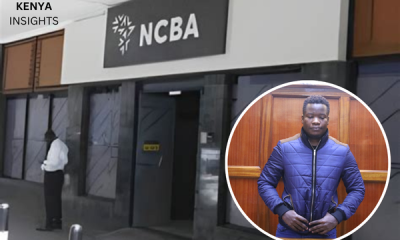
 Business2 weeks ago
Business2 weeks agoHow NCBA Software Engineer Opened Floodgates For Mobile Banking System Fraud
-

 Investigations1 week ago
Investigations1 week agoEXCLUSIVE: How Corruption and Mismanagement Have Brought Kenyatta National Hospital to Its Knees
-
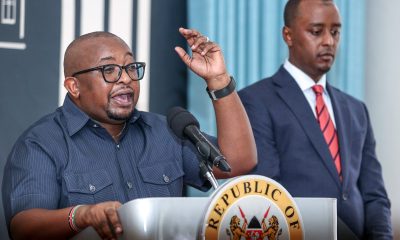
 Investigations1 week ago
Investigations1 week agoHousing PS Charles Hinga Entangled in Sh 2B Tender Scam
-
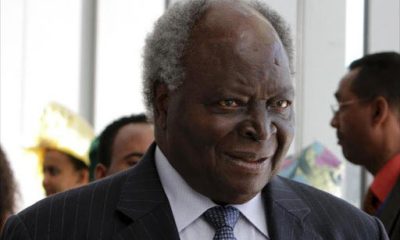
 Investigations1 week ago
Investigations1 week agoInside the Kibaki Estate Dispute: Power, Bloodlines & the Unfolding Legal Drama
-

 Opinion2 weeks ago
Opinion2 weeks agoHow Deep is DIG Lagat in The Kenyan Deep State?
-

 News2 weeks ago
News2 weeks agoBoda Boda Rider Robbed in Nakuru—Only to Find His Attackers Were POLICE OFFICERS at the Station When He Went to Report!
-

 Investigations1 week ago
Investigations1 week agoCourt Ruling Leaves Agnes Kagure Exposed in Sh600M Land Fraud Targeting Foreigners
